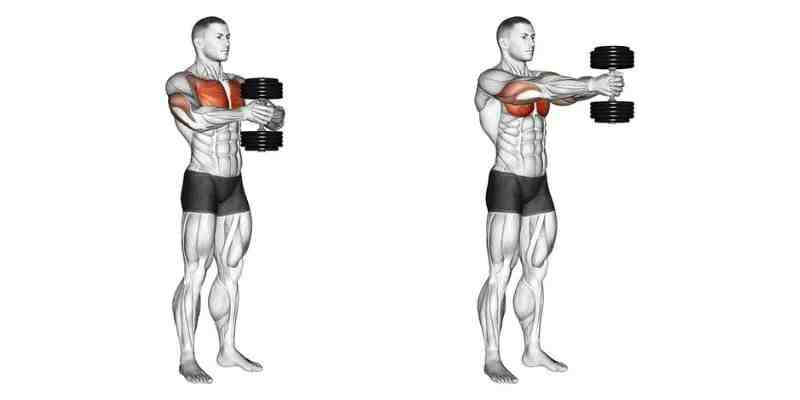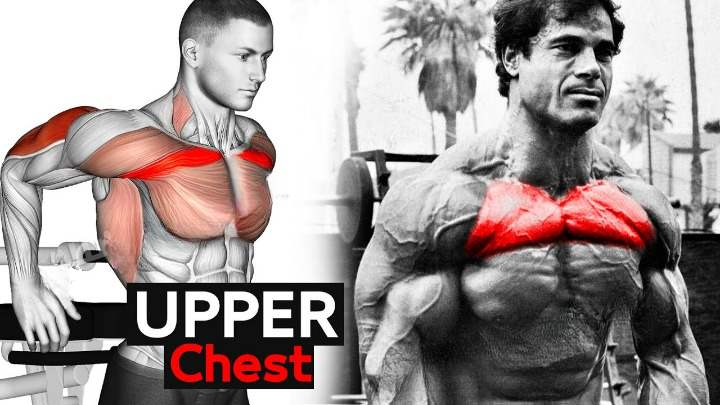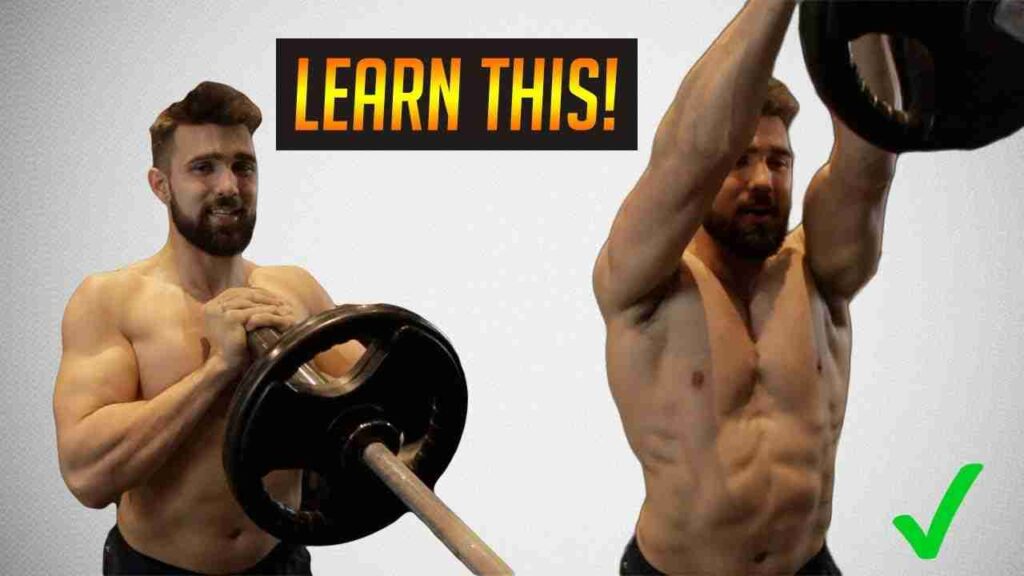Introduction
Have you ever wondered how to get a bigger and stronger chest without using a bench or a barbell? If so, you are not alone. Many people struggle to find effective chest exercises that they can do at home or in a small space. Fortunately, there is a simple solution: standing dumbbell chest workouts.
In this article, you will learn how to use dumbbells to sculpt and define your chest muscles from a standing position. You will discover 12 different exercises that target your upper, middle, and lower chest, as well as your serratus anterior and pectoralis minor.
SHOP FOR THE ADJUSTABLE DUMBBELLS ON AMAZON
You will also learn how to perform each exercise with proper form and technique, and how to incorporate them into your chest workout routine. By the end of this article, you will be able to build a powerful and impressive chest with just a pair of dumbbells and a few feet of floor space.
Benefits of Standing Dumbbell Chest Workouts
One of the benefits of standing dumbbell chest workouts is that they can improve your functional strength, which is the ability to perform everyday tasks with ease and efficiency. Functional strength involves using multiple muscle groups in coordination, rather than isolating one muscle at a time. Standing dumbbell chest exercises require you to balance and stabilize your core, legs, and arms, while also engaging your chest muscles. This can help you develop better posture, mobility, and power.
Another benefit of standing dumbbell chest workouts is that they can enhance your muscle growth, especially if you are looking for more variety and challenge in your training. Standing dumbbell chest exercises allow you to work your chest from different angles and ranges of motion, which can stimulate more muscle fibers and increase muscle hypertrophy. For example, standing dumbbell flys can target your upper, middle, and lower chest, as well as your serratus anterior and pectoralis minor. Standing dumbbell chest exercises can also help you overcome plateaus and avoid boredom by adding some diversity and fun to your routine.
SHOP FOR THE ADJUSTABLE WORKOUT BENCH ON AMAZON
A third benefit of standing dumbbell chest workouts is that they can reduce your injury risk, especially if you have shoulder issues or joint pain. Standing dumbbell chest exercises do not place your shoulder joint in a compromising position, unlike some bench press or barbell movements. Standing dumbbell chest exercises also allow you to adjust the weight, grip, and angle of the dumbbells to suit your individual needs and preferences. This can help you avoid excessive stress and strain on your joints, tendons, and ligaments, and prevent injuries such as rotator cuff tears, impingement, or bursitis.
They can improve your cardiovascular health and endurance, especially if you perform them with high intensity and low rest intervals. Standing dumbbell chest exercises can elevate your heart rate and oxygen consumption, which can boost your blood circulation and lung capacity. This can help you lower your blood pressure, cholesterol, and risk of heart disease and stroke.
Is Pec Deck Better than Cable Fly?
They can increase your caloric expenditure and fat loss, especially if you combine them with a balanced diet and other forms of exercise. Standing dumbbell chest exercises can burn more calories than sitting or lying down, as they require more energy and muscle activation. They can also increase your metabolic rate and muscle mass, which can help you burn more calories and fat even at rest.
In conclusion, standing dumbbell chest workouts can offer many benefits for your health, fitness, and performance. They can improve your functional strength, enhance your muscle growth, and reduce your injury risk. They can also be done at home or in a small space, with minimal equipment and space.
Top Standing Dumbbell Chest Workouts
When it comes to sculpting a powerful and well-defined chest, standing dumbbell chest workouts are a game-changer. Here are some of the top standing dumbbell chest exercises that you can incorporate into your workout routine:
Standing dumbbell flys

This exercise targets your upper, middle, and lower chest, as well as your serratus anterior and pectoralis minor. To perform this exercise, hold a pair of dumbbells with a neutral grip and extend your arms to the sides at shoulder level. Keeping a slight bend in your elbows, bring the dumbbells together in front of your chest, squeezing your pecs. Return to the starting position and repeat.
Standing upward chest fly
This exercise works on your upper chest and front deltoids. To perform this exercise, hold a pair of dumbbells with a neutral grip and extend your arms down in front of your thighs. Keeping your arms straight, raise the dumbbells up and out to the sides until they are above your head, forming a V shape. Lower the dumbbells back to the starting position and repeat.
Standing Svend press

This exercise is a variation of the chest press that uses a weight plate instead of dumbbells. It challenges your chest, triceps, and core stability. To perform this exercise, hold a weight plate between your palms and press it against your chest. Keeping your elbows close to your body, extend your arms and squeeze the plate as hard as you can. Bring the plate back to your chest and repeat.
Standing dumbbell chest press
This exercise is similar to the bench press, but you do it while standing. It works on your chest, triceps, and shoulders. To perform this exercise, hold a pair of dumbbells with a neutral grip and bring them to your chest level. Press the dumbbells up and slightly inwards, extending your arms fully. Lower the dumbbells back to the starting position and repeat.
Standing dumbbell pullover
This exercise targets your lower chest, lats, and triceps. To perform this exercise, hold a single dumbbell with both hands and extend your arms overhead. Keeping your arms straight, lower the dumbbell behind your head until you feel a stretch in your chest and lats. Raise the dumbbell back to the starting position and repeat.
Standing dumbbell squeeze press
This exercise is a variation of the chest press that involves squeezing the dumbbells together throughout the movement. It activates your chest, triceps, and biceps. To perform this exercise, hold a pair of dumbbells with a neutral grip and press them together in front of your chest. Keeping the dumbbells in contact, press them up and slightly inwards, extending your arms fully. Lower the dumbbells back to the starting position and repeat.
SHOP FOR THE BEST QUALITY PROTEIN SUPPLEMENTS ON AMAZON
Integrating standing dumbbell chest workouts into your routine can significantly enhance your chest development and overall upper body strength. Remember to prioritize proper form, gradually increase the intensity, and stay consistent for optimal results. Elevate your chest training and sculpt a powerful upper body with these effective standing dumbbell exercises.
Tips for Standing Dumbbell Chest Workout
A standing dumbbell chest workout is a fantastic way to build strength and sculpt your upper body. To maximize the effectiveness of your routine and ensure you’re reaping the full benefits, consider these easy and precise tips:
- Warm up properly before starting your workout. Warming up can help you prevent injuries, improve your performance, and prepare your muscles and joints for the exercises. You can do some dynamic stretches, light cardio, or some easy sets of the exercises you plan to do.
- Choose the right weight and number of reps for your goal. Depending on whether you want to build strength, muscle size, or endurance, you may need to adjust the weight and number of reps of your dumbbell exercises. As a general rule, heavier weights and lower reps (6-12) are better for strength and size, while lighter weights and higher reps (15-20) are better for endurance.
- Focus on your form and technique. Proper form and technique are essential for getting the most out of your dumbbell chest exercises and avoiding injuries. Make sure you keep your chest up, shoulders back, core tight, and elbows slightly bent throughout the movements. Avoid jerking, bouncing, or swinging the dumbbells, and control the tempo of each rep.
- Vary your exercises and angles. To target different parts of your chest and prevent boredom and plateaus, you should vary your exercises and angles regularly. For example, you can do standing dumbbell flys, presses, pullovers, squeeze presses, and more. You can also change the angle of your arms and dumbbells to hit your upper, middle, or lower chest.
- Rest and recover adequately. Rest and recovery are just as important as the workout itself, as they allow your muscles to repair and grow. You should rest for at least 48 hours between chest workouts, and get enough sleep, hydration, and nutrition. You can also do some active recovery activities, such as walking, stretching, or foam rolling, to enhance blood flow and reduce soreness.
CHEST WORKOUTS FOR STRENGTH AND SHAPE
Incorporating these tips into your standing dumbbell chest workout routine can make a significant difference in your progress.
Common Mistakes to Avoid
Some common mistakes to avoid when doing standing dumbbell chest exercises are:
- Going too heavy. The standing dumbbell fly is an isolation exercise that requires moderate weights and a slow and controlled range of motion. Using heavier dumbbells than you can handle can compromise your form, reduce your chest activation, and increase your risk of injury.
- Leaning forward. Many lifters tend to lean forward while performing this exercise, which can result in greater involvement of the front deltoids and less of the chest muscles. To avoid this, keep your torso upright, your chest out, and your shoulders back.
- Holding your breath. Breathing properly is important for any exercise, but especially for the standing dumbbell fly, which can put a lot of pressure on your chest and core. Holding your breath can cause dizziness, nausea, and fainting. To avoid this, inhale as you lower the dumbbells and exhale as you bring them together.
- Slumping your back. Slumping your back when squeezing the dumbbells removes some of the work from your chest and shifts it to your arms and shoulders. This can also cause lower back pain and poor posture. To avoid this, arch your lower back and retract your scapula to keep your chest engaged and your spine aligned.
- Flaring your elbows. Flaring your elbows out too much can reduce the tension on your chest and increase the stress on your shoulders. This can lead to shoulder impingement, inflammation, or injury. To avoid this, keep your elbows slightly tucked in and aligned with your wrists.
- Not squeezing your chest. The standing dumbbell fly is a chest isolation exercise that requires you to contract your pecs hard at the top of the movement. Not squeezing your chest can result in less muscle activation and growth. To avoid this, imagine you are hugging a barrel or a tree trunk and squeeze your chest as hard as you can.
- Not using a full range of motion. The standing dumbbell fly allows you to stretch and contract your chest through a large range of motion. Not using a full range of motion can limit your muscle development and performance. To avoid this, lower the dumbbells until they are at shoulder level or slightly below, and bring them together until they touch or almost touch.
SHOP FOR THE FITNESS TRACKER ON AMAZON
By avoiding these common mistakes, you’ll enhance the effectiveness of your standing dumbbell chest workout, reduce the risk of injury, and ensure steady progress towards your fitness goals.
FAQs
Q 1. Can beginners perform the standing dumbbell chest workout?
Ans. Absolutely! The standing dumbbell chest workout is versatile and can be adapted to various fitness levels. Beginners are encouraged to start with lighter weights and focus on mastering the form before gradually increasing the resistance.
Q 2. How often should I include this workout in my routine?
Ans. The frequency of the standing dumbbell chest workout depends on your overall fitness goals and training routine. However, as a general guideline, performing this exercise 1 to 2 times a week can be effective in building and toning chest muscles. Allow sufficient rest between sessions for muscle recovery.
Q 3. Are there any alternative exercises for those with shoulder issues?
Ans. If you have shoulder concerns, it’s crucial to consult with a healthcare professional before starting any new workout routine. Alternatives such as seated chest exercises or machine-based chest presses may be considered, as they provide more stability and put less strain on the shoulders.
Q 4. Can I perform this workout at home without a spotter?
Ans. Yes, the standing dumbbell chest workout can be adapted for home workouts. However, when lifting heavy weights, especially if you’re alone, it’s essential to prioritize safety. Choose a weight that allows you to maintain proper form, and consider using a bench or stability ball for added support.
Q 5. Is there an ideal time to incorporate this exercise into my workout session?
Ans. The best time to include the standing dumbbell chest workout depends on your personal preference and schedule. Some individuals prefer to target larger muscle groups, like the chest, earlier in their workout, while others may incorporate it later. The key is consistency, so choose a time that aligns with your routine and allows for a focused and effective workout.
Conclusion
Achieving a well-defined chest doesn’t always require complex exercises. The standing dumbbell chest workout, often overlooked, can be your secret weapon in the pursuit of chest gains. By understanding the fundamentals, embracing variations, and following our step-by-step guide, you’re on your way to not just performing this exercise but mastering it for optimal results.

Good day, and welcome to Fitthour. My name is Shubham Vijay, and I am a certified personal trainer and nutrition coach with 6 years of experience in the fitness industry. At Fitthour, we specialize in types of training, such as strength training, cardio, or HIIT, and our mission is to help clients achieve their fitness goals and improve their overall health.




